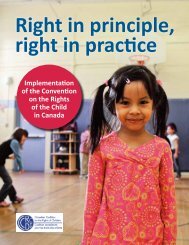Poste - Canadian Coalition for the Rights of Children
Poste - Canadian Coalition for the Rights of Children
Poste - Canadian Coalition for the Rights of Children
Create successful ePaper yourself
Turn your PDF publications into a flip-book with our unique Google optimized e-Paper software.
Positive Factor<br />
C A N A D I A N C O A L I T I O N F O R T H E R I G H T S O F C H I L D R E N<br />
• <strong>Children</strong>’s Bureau <strong>for</strong> ensuring that <strong>the</strong> UNCRC<br />
is taken into account in <strong>the</strong> development and<br />
implementation <strong>of</strong> federal policies and activities to<br />
disseminate Convention in<strong>for</strong>mation<br />
Update<br />
• Since Canada’s last report to <strong>the</strong> UN Committee,<br />
<strong>the</strong> <strong>Children</strong>’s Bureau has ceased to exist as a<br />
separate entity. There is little public in<strong>for</strong>mation<br />
about how <strong>the</strong> federal government monitors<br />
Canada’s ongoing implementation <strong>of</strong> <strong>the</strong><br />
Convention. However, <strong>the</strong> Health Canada Web site<br />
reports that <strong>the</strong> Strategic Policy and Systems<br />
Coordination Unit, Childhood and Youth Division,<br />
Health Canada supports “departmental and<br />
interdepartmental coordination <strong>of</strong> child and youth<br />
health and well-being issues, as well as issues<br />
related to children’s rights from a domestic and<br />
international perspective.” 3<br />
Positive Factor<br />
• government’s expressed commitment to reduce child<br />
poverty, despite <strong>the</strong> economic recession<br />
Update<br />
• Statistics Canada reports that <strong>the</strong> incidence <strong>of</strong><br />
low income among children under 18 years <strong>of</strong> age<br />
was 21.3 percent (an estimated 1,484,000 children)<br />
in 1993, 19.5 percent (1,362,000) in 1994,<br />
21.0 percent (1,472,000) in 1995, 21.1 percent<br />
(1,498,000) in 1996, and 19.8 percent (1,397,000)<br />
in 1997. 4<br />
Positive Factor<br />
• ef<strong>for</strong>ts by schools and social services <strong>for</strong> <strong>the</strong> early<br />
identification <strong>of</strong> children’s disabilities<br />
Update<br />
• The <strong>Coalition</strong>’s research indicates that <strong>the</strong>re is<br />
insufficient funding <strong>for</strong> <strong>the</strong> early diagnosis <strong>of</strong><br />
children with disabilities and insufficient supports<br />
and services. A full discussion <strong>of</strong> <strong>the</strong> issue can be<br />
found in <strong>the</strong> research paper on Article 23, <strong>Children</strong><br />
with Disabilities.<br />
128<br />
Positive Factor<br />
• Canada’s cooperation with UNICEF and o<strong>the</strong>r<br />
organizations<br />
Update<br />
• Canada continues to cooperate with international<br />
organizations and although children’s rights are a<br />
stated <strong>for</strong>eign policy priority, spending on overseas<br />
development assistance has declined an average <strong>of</strong><br />
3.3 percent per year from 1990-91 to 1995-96. A full<br />
discussion <strong>of</strong> <strong>the</strong> issue can be found in <strong>the</strong> research<br />
paper on Article 4, International Cooperation to<br />
Promote and Enhance <strong>Children</strong>’s <strong>Rights</strong>.<br />
Concerns and<br />
Recommendations<br />
Cited by <strong>the</strong> Committee<br />
Concern<br />
• jurisdictional issues and disparities<br />
Recommendation<br />
• better legal and administrative coordination across<br />
jurisdictions to reduce disparities in children’s rights<br />
across <strong>the</strong> country<br />
Update<br />
• The devolution <strong>of</strong> federal responsibilities to <strong>the</strong><br />
provinces is a growing trend in <strong>the</strong> context <strong>of</strong> <strong>the</strong><br />
current social union agreement, which has <strong>the</strong><br />
potential to lead to greater variations in programs and<br />
services <strong>for</strong> children and families. For example, <strong>the</strong><br />
Canada Assistance Plan framework <strong>for</strong> federal tax<br />
transfers to share social assistance costs with <strong>the</strong><br />
provinces has been replaced by <strong>the</strong> Canada Health<br />
and Social Transfer, which provides block funding<br />
and gives <strong>the</strong> provinces greater discretion in deciding<br />
how <strong>the</strong> money will be spent.<br />
• The <strong>Coalition</strong>’s research papers illustrate <strong>the</strong> overall<br />
lack <strong>of</strong> national goals and standards <strong>for</strong> protecting<br />
children’s rights and well-being.




